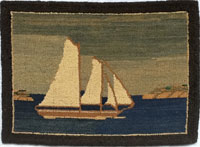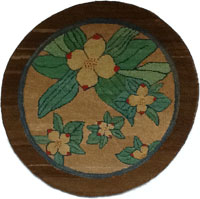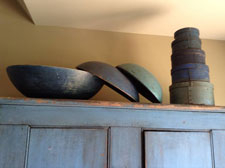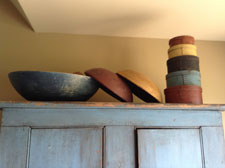|
Grenfell Hooked Textiles – From Philanthropy to Folk Art
 Grenfell hooked mats and rugs are known for the quality of the hooking and delightful patterns. These rugs were made in Labrador and Newfoundland as part of an organized effort started by Dr. Wilfred T. Grenfell. Travelling by ship to remote locations from Britain, Dr. Grenfell would offer medical services and look for ways to improve the condition of the local people he was serving. Grenfell hooked mats and rugs are known for the quality of the hooking and delightful patterns. These rugs were made in Labrador and Newfoundland as part of an organized effort started by Dr. Wilfred T. Grenfell. Travelling by ship to remote locations from Britain, Dr. Grenfell would offer medical services and look for ways to improve the condition of the local people he was serving.
By the time Dr. Grenfell and his wife arrived in Labrador in 1892, the tradition of hooking was well established with many skilled “hookers” learning the craft from early childhood. The months of February and March were known as the “matting season” – a time of respite from the fishing season with long days indoors. The mats and rugs were hooked from very narrow and thin strips of scrap fabric. Loops of the fabric were pushed closely together through every opening in the weave of the burlap base – as many as 200 loops to the inch. The end result was a tightly woven, thin, smooth surface that was very durable. The early patterns were designed by the women with blocks or triangles arranged like a patchwork quilt was well as floral motifs.
The people in this region were poor and fighting terrible odds against chronic disease, hunger, poverty and exploitation. Dr. Grenfell was determined to find a way to alleviate their distress, but he felt strongly that gifts of money, food and clothing would offer no long term help. Instead he wanted to find a way to lead them to be self-sufficient which led to the development of a cottage industry known as "the Industrial.” Dr. Grenfell was offered rugs as payment for his medical services. Although he was not impressed with the color and design, he did recognize the quality of the hooking and thought that these could be used to generate income.
In 1906, Jessie Luther, an American woman, join Dr. Grenfell and his wife in Newfoundland to supervise and organize the women. The Industrials developed standards in design, color and size. They created kits which included the design drawn on burlap (locally called “brin”) and the fabric necessary to complete the project. Sixteen mission picture mats, many designed by Grenfell himself, were in production by 1916. Distinctly northern images - dog teams, snowy owls and polar bears - were now in the centre of the mat.

Grenfell Crackerberry Design | The hooking materials given out in the early Grenfell materials packages were new cottons of various sorts. Some of the floral designs of the 1920s were hooked using cotton, wool, brin and silk. The move to silk and rayon as the predominant Grenfell hooking materials was made in the later 1920s. Silk had been used in small amounts before, but now it became a clear emphasis in the requests Grenfell made for materials. The materials for the kits were procured from donations from the US, Canada and Great Britain. In fact, in one year ten tons of old silk stockings were donated to the Grenfell hooking project. |
The philanthropy was in full swing with the materials being donated and the resulting mats, rugs and even bags sold back to many of the original donors. During the 1930s, enthusiastic mission volunteers toured the resort areas of New England and New York, holding sales. Retail shops were opened in New York City and in Philadelphia. The establishment of the Dog Team Tavern in Ferrisburg, Vermont, in 1931 provided additional distribution for the products. Alas, the effects of the Great Depression and World War II began the decline of the Industrials.
During much of their production, Grenfells were labeled. There were at least ten different versions of the labels. When looking at a Grenfell, you will see that the hooking is tight, the loops are very fine and straight and the designs are very folky. From the philanthropy inspired by Dr. Grenfell to the products produced by the women of Newfoundland and Labrador, today we can collect these wonderful examples of folk art
Search for Grenfell rugs and mats on Dig Antiques.
References:
- Grenfell Hooked Mats, Paula Laverty.
- Paula Laverty on "Grenfell" Hooked Rugs, R. John Howe, March 6, 2010.
- Rugs to Riches: Grenfell Hooked Textiles, Chubb Collectors, Helaine Fendelmen, March 2004.
- Silk Stocking Mats: Hooked Mats of the Grenfell Mission, Paula Laverty, McGill-Queen's University Press, May 2005.
|
|
Monochromatic vs. Polychromatic Decor
Written by Guest Columnist: Lyn Andeen
There tends to be two very different ways of decorating; monochromatic or polychromatic.
Neither is right nor wrong, just different and a personal preference.
Back when I was a dealer in Massachusetts I had a dealer friend who would arrange her house and shop with all the same color. I found her spaces to be very restful and even though there were many objects in a space it seemed not cluttered. You can find this style in many books and magazines. If you are big fan of blue, for example, you would group all your blue items together. If any of you have ever seen my booth at a show or my home you know I lack the discipline to carry this out. I just like too many colors and prefer to at the very least have opposite colors together. This enhances the colors of both.
Before I tackled this article I looked up monochromatic vs. polychromatic and found an interesting article that linked certain ethnic backgrounds to each. They were speaking more culturally and not about preferences in color grouping but I found it interesting that they found certain groups such as Germans to be monochromatic. They did one thing at a time, usually well, and in a planned order. Italians were classically polychromatic, often attempting many tasks simultaneously, and displaying more spontaneity.
Whether ethnic background plays any part in our preference is up for discussion. I think it has more to do with personality and personal aesthetic preferences than ethnic background. Perhaps we choose polychromatic decor because that's what is available to us. Perhaps we just prefer certain colors and stick to them.

Monochromatic Example |

Polychromatic Example |
I have set up two pictures displaying each style. Go to the Dig Antiques Facebook and choose your preference. You can also weigh in on whether you think ethnic background or personality traits contribute to one’s preference
About Lyn Andeen
Lyn Andeen has been an avid collector and dealer for the past 28 years. She has been in group shops, setup at countless antique shows and has a true artistic eye. Lyn's passion is for quality 18th through early 20th century Americana, decorative arts, Shaker and folk art. You can find Lyn online through Andeen Antiques.
|
|
Summer Ending
The nights are getting colder and the daylight is shorter. Where has the summer gone to? We've had a wonderful couple of months spending time with family, friends and antiquing at shows and shops. We hope your summer has been enjoyable too.
We have so much more to look forward to! On September 7-8, we'll be exhibiting at the 31st Annual Tinicum Park Antiques Show in Erwinna, PA (Bucks County). We are looking forward to seeing our antique friends at this show. We hope you will stop in and say hi. We still have Dig Antiques bags that we are sharing with anyone that would like one..
Sincerely,
Tom & Sheila Baker
diginfo@digantiques.com
We Dig It...do you? Dig Antiques - Real stuff without the fluff.
 
|




